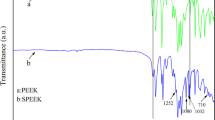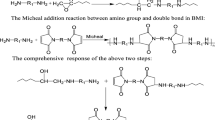Abstract
Octyl(triphenylethynyl)silane monomer(OTPES) was synthesized with ethyl bromide, octyltrichlorosilane and phenylethylene by Grignard reaction. The molecular structure was confirmed by FTIR and NMR. The poly[octyl(triphenylethynyl)]silane resin(POTPES) was prepared by thermal polymerization and the corresponding thermal degradation behavior wasstudied by thermogravimetric analysis(TG) combining with model and model-free fitted methods. The dielectric property of resin was also studied by vector network analyzer. The results show that the melt point of OTPES was 50 °C and the processing window was over 236 °C. The resin degradation temperature of Td5 occurred over 433 °C and the char yield was over 60% at 800 °C. Based on Kissinger, Flynn-Wall-Ozawa, Coats-Redfern, Achar, Vyazovkin-Wight and Tang methods, the reaction activity(E) was 155.51, 152.97, 150.82, 146.02, 148.38 and 148.77 kJ/mol, respectively. Dielectric properties analysis displayed that the real part(ε′) and the imaginary part(ε″) of the relative complex permittivity of POTPES was 2.5 and 0.05, respectively, and the dielectric loss tangent was between 0.03 and 0.25. The reflection loss of resin was more than −2.85 dB in all range of 1–5 mm thicknesses and 2–18 GHz frequency, which indicated that POTPES resin was a real wave-transparent resin matrix.
Similar content being viewed by others
References
Dhanalakshmi J. P., Raj M. A., Vijayakumar C. T., Chinese J. Polym. Sci., 2016, 34, 253
Wunderlich B., Basics of Thermal Analysis(2nd Ed.), Springer, Berlin, New York, 2005
Vyazovkin S., Sbirrazzuoli N., Macromol. Rapid Commun., 2006, 27, 1515
Balart R., Garcia D., Quiles L., Polymers, 2019, 11, 281
Guo J., Wang J., Wu Y., He Y., Song H., Chen X., Polym. Eng. Sci., 2019, 59, 246
Li H., Fu Y., Liu H., Sun C., Li R., Song L., Yang A., J. Polym. Eng., 2019, 39, 105
Melissaris A. P., Litt M. H., Macromolecules, 1994, 27, 2675
Zhou Q., Feng X., Ni L., J. Appl. Polym. Sci., 2006, 102, 2488
Tan D., Shi T. Li Z., Res. Chem. Intermed., 2011, 37, 831
Cai M., Yuan Q., Huang F., Int Polym.., 2018, 67, 1563
Wrackmeyer B., Khan E., Bayer S., Z. Naturforsch B., 2010, 65, 725
Itoh M., Inoue K., Iwata K., Adv. Mater., 1997, 9, 1187
Sellers K. W., Towns C. M., Mubarak C. R., J. Anal. Appl. Pyrolysis, 2002, 64, 313
Zhang J., Huang J., Du W., Polym. Degrad. Stab., 2011, 96, 2276
Guo K., Li P., Zhu Y., Polym. Degrad. Stab., 2016, 131, 98
Kuroki S., Kakigano K. O., Ishikawa J., Itoh M., Macromolecules, 1998, 31, 2804
Ren Y., Cheng B., Zhang J., Chem. Res. Chinese Universities, 2008, 24(5), 628
Askari F., Barikani M., Barmar M., Iran. Polym. J., 2015, 24, 783
Tang W., Liu Y., Zhang H., Wang C., Thermochimica Acta, 2003, 408, 39
Chen Y., You X., Deng S., J. Mater. Sci. Chem. Eng., 2018, 7, 1
Acknowledgments
This work was supported by the Overseas Scholarship Program for Elite Young and Middle-aged Teachers of Lingnan Normal University, China and the Research Center for Clean Energy Materials Chemical Engineering Technology of Guangdong Province, China.
Author information
Authors and Affiliations
Corresponding author
Additional information
Supported by the Natural Science Foundation of Guangdong Province, China(No.2017A030307028), the Special Fund for Science and Technology Innovation Strategy of Guangdong Province, China(No.2018A01005), the Yangfan Plan of Guangdong Province, China(No.0003017011) and the Research Initiation Foundation of the Lingnan Normal University, China(Nos.ZL1604, ZL1822).
Rights and permissions
About this article
Cite this article
Wang, Y., Tan, D. Synthesis, Thermal Degradation and Dielectric Properties of Poly[octyl(triphenylethynyl)]silane Resin. Chem. Res. Chin. Univ. 35, 1076–1081 (2019). https://doi.org/10.1007/s40242-019-9170-x
Received:
Accepted:
Published:
Issue Date:
DOI: https://doi.org/10.1007/s40242-019-9170-x




